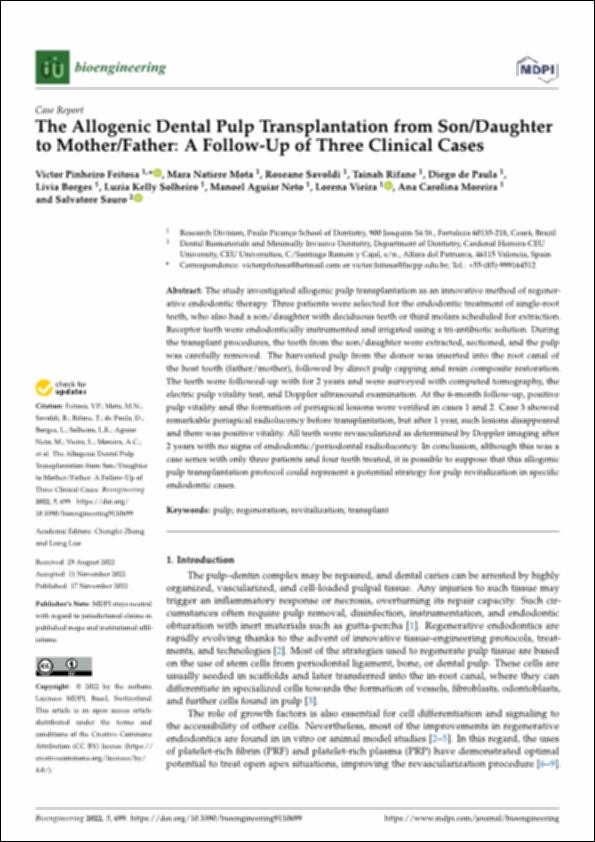Por favor, use este identificador para citar o enlazar este ítem:
http://hdl.handle.net/10637/14342The allogenic dental pulp transplantation from son-daughter to mother-father a follow-up of three clinical cases
| Título : | The allogenic dental pulp transplantation from son-daughter to mother-father a follow-up of three clinical cases |
| Autor : | Feitosa, Victor Pinheiro Mota, Mara Natiere Savoldi, Roseane Rifane, Tainah Paula, Diego M. de Borges, Livia Sauro, Salvatore. |
| Materias: | Pulpa dental - Transplante.; Pulpa dental - Regeneración.; Terapéutica dental.; Dental pulp - Transplantation.; Endodoncia.; Endodontics.; Dental pulp - Regeneration.; Dental therapeutics. |
| Editorial : | MDPI |
| Citación : | Feitosa, V. P., Mota, M. N., Savoldi, R., Rifane, T., de Paula, D., Borges, L., Solheiro, L. K., Aguiar Neto, M., Vieira, L., Moreira, A. C. & Sauro, S. (2022). The allogenic dental pulp transplantation from son/daughter to mother/father: a follow-up of three clinical cases. Bioengineering, vol. 9, i. 11 (17 nov.), art. 699. DOI: https://doi.org/10.3390/bioengineering9110699 |
| Resumen : | The study investigated allogenic pulp transplantation as an innovative method of regenerative endodontic therapy. Three patients were selected for the endodontic treatment of single-root teeth, who also had a son/daughter with deciduous teeth or third molars scheduled for extraction. Receptor teeth were endodontically instrumented and irrigated using a tri-antibiotic solution. During the transplant procedures, the teeth from the son/daughter were extracted, sectioned, and the pulp was carefully removed. The harvested pulp from the donor was inserted into the root canal of the host tooth (father/mother), followed by direct pulp capping and resin composite restoration. The teeth were followed-up with for 2 years and were surveyed with computed tomography, the electric pulp vitality test, and Doppler ultrasound examination. At the 6-month follow-up, positive pulp vitality and the formation of periapical lesions were verified in cases 1 and 2. Case 3 showed remarkable periapical radiolucency before transplantation, but after 1 year, such lesions disappeared and there was positive vitality. All teeth were revascularized as determined by Doppler imaging after 2 years with no signs of endodontic/periodontal radiolucency. In conclusion, although this was a case series with only three patients and four teeth treated, it is possible to suppose that this allogenic pulp transplantation protocol could represent a potential strategy for pulp revitalization in specific endodontic cases. |
| Descripción : | Este artículo se encuentra disponible en la siguiente URL: https://www.mdpi.com/2306-5354/9/11/699 Este artículo de investigación pertenece al número especial "Recent Advances in Biomaterials and Dental Disease". En este artículo de investigación también participan: Luzia Kelly Solheiro, Manoel Aguiar Neto, Lorena Vieira y Ana Carolina Moreira. |
| URI : | http://hdl.handle.net/10637/14342 |
| Derechos: | http://creativecommons.org/licenses/by/4.0/deed.es |
| ISSN : | 2306-5354 (Electrónico) |
| Idioma: | es |
| Fecha de publicación : | 17-nov-2022 |
| Centro : | Universidad Cardenal Herrera-CEU |
| Aparece en las colecciones: | Dpto. Odontología |
Los ítems de DSpace están protegidos por copyright, con todos los derechos reservados, a menos que se indique lo contrario.


